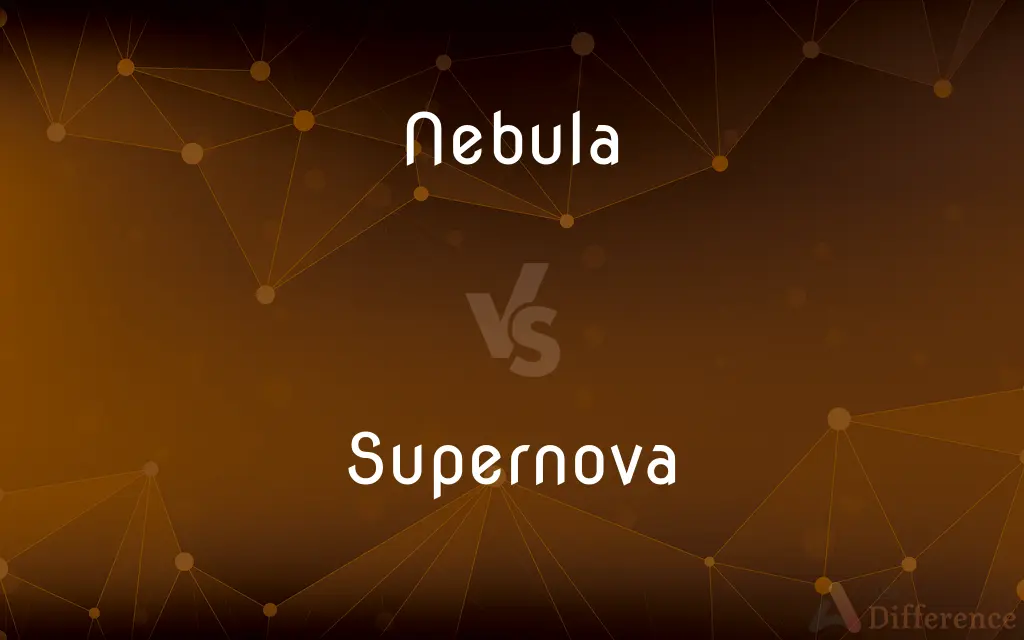Nebula vs. Supernova — What's the Difference?
By Tayyaba Rehman & Maham Liaqat — Updated on April 14, 2024
Nebulae are vast clouds of gas and dust in space, often where stars form, while supernovae are explosive events that mark the end of a star's life.

Difference Between Nebula and Supernova
Table of Contents
ADVERTISEMENT
Key Differences
Nebulae serve as cosmic nurseries where stars are born from concentrations of gas and dust, whereas supernovae occur when a star reaches the end of its life cycle, resulting in a massive explosion.
Nebulae can appear as glowing masses in the sky due to the ionization of gases by young, hot stars forming within them, while supernovae are characterized by a sudden, dramatic increase in brightness followed by a gradual fading.
The composition of nebulae includes hydrogen, helium, and other ionized gases, which provide the raw material for star formation, whereas a supernova often disperses heavy elements into space, contributing to the cosmic chemical enrichment.
Nebulae may be visible for millions of years as they slowly evolve, on the other hand, supernovae are transient events that are visible for a short period, typically a few months to years.
Nebulae often exhibit varied shapes and colors depending on their type and the light from nearby stars, while supernovae remnants can also show complex structures but are mainly noted for their radiative output and the shock waves they send through surrounding space.
ADVERTISEMENT
Comparison Chart
Definition
Clouds of gas and dust in space.
Explosive end of a star’s life.
Visibility Duration
Can be visible for millions of years.
Briefly visible, typically months to years.
Role in Star Cycle
Star formation regions.
Star death events.
Light Characteristics
Often glow due to ionization.
Brightens suddenly, then fades.
Contribution
Contributes to star birth.
Disperses elements, aiding cosmic chemistry.
Compare with Definitions
Nebula
Emission nebula.
The Horsehead Nebula glows red due to the ionization of hydrogen.
Supernova
Type Ia supernova.
This type of supernova occurs in binary systems.
Nebula
Stellar nursery.
The Orion Nebula is known for being a prolific region of star formation.
Supernova
Type II supernova.
Supernovas of this type result from the core collapse of massive stars.
Nebula
Planetary nebula.
The Ring Nebula is the result of a star shedding its outer layers.
Supernova
Stellar explosion.
Supernova 1987A was visible to the naked eye.
Nebula
Dark nebula.
The Coal Sack Nebula is visible as a dark patch against the Milky Way.
Supernova
Supernova remnant.
The Crab Nebula is the remnant of a supernova observed in 1054.
Nebula
Reflection nebula.
The Pleiades are surrounded by a reflection nebula, illuminated by starlight.
Supernova
Neutron star formation.
Supernovae often leave behind dense neutron stars.
Nebula
A nebula (Latin for 'cloud' or 'fog'; pl. nebulae, nebulæ or nebulas) is an interstellar cloud of dust, hydrogen, helium and other ionized gases.
Supernova
A supernova ( plural: supernovae or supernovas, abbreviations: SN and SNe) is a powerful and luminous stellar explosion. This transient astronomical event occurs during the last evolutionary stages of a massive star or when a white dwarf is triggered into runaway nuclear fusion.
Nebula
A cloud of gas and dust in outer space, visible in the night sky either as an indistinct bright patch or as a dark silhouette against other luminous matter.
Supernova
A rare celestial phenomenon involving the explosion of a star and resulting in an extremely bright, short-lived object that emits vast amounts of energy. Depending on the type of supernova, the explosion may completely destroy the star, or the stellar core may survive to become a neutron star.
Nebula
A clouded spot on the cornea causing defective vision.
Supernova
(star) The explosion of a star, which increases its absolute magnitude to typically a billion times that of our sun. Some leave only debris, while others fade to invisibility as neutron stars or black holes.
Nebula
A diffuse cloud of interstellar dust or gas or both, visible as luminous patches or areas of darkness depending on the way the mass absorbs or reflects incident light or emits its own light.
Supernova
(figurative) Something brilliant.
Nebula
A galaxy. No longer in technical use.
Supernova
A star that explodes and becomes extremely luminous in the process
Nebula
A cloudy spot on the cornea.
Nebula
A liquid preparation for use in a nebulizer.
Nebula
(astronomy) A cloud in outer space consisting of gas or dust (e.g. a cloud formed after a star explodes).
Nebula
A white spot or slight opacity of the cornea.
Nebula
A cloudy appearance in the urine.
Nebula
A faint, cloudlike, self-luminous mass of matter situated beyond the solar system among the stars. The term was originally applied to any diffuse luminous region. Now, technically, it is applied to interstellar clouds of dust and gases (diffuse nebula). However distant galaxies and very distant star clusters often appear like them in the telescope, such as the spiral nebula in Andromeda, known now to be a distant galaxy.
Nebula
A white spot or a slight opacity of the cornea.
Nebula
A medicinal liquid preparation intended for use in an atomizer
Nebula
Cloudiness of the urine
Nebula
An immense cloud of gas (mainly hydrogen) and dust in interstellar space
Nebula
(pathology) a faint cloudy spot on the cornea
Common Curiosities
What is a nebula?
A nebula is a large cloud of gas and dust in space, often involved in star formation.
Are all nebulae remnants of supernovae?
Not all nebulae are supernova remnants; many are regions of active star formation or the result of other processes in space.
What types of nebulae are there?
There are several types of nebulae, including emission nebulae, which glow due to ionized gases; reflection nebulae, which reflect the light of nearby stars; dark nebulae, which block light from more distant stars; and planetary nebulae, formed from the expelled material of dying stars.
Can nebulae and supernovae be dangerous?
While both phenomena occur at great distances from Earth and pose no direct danger, the intense radiation from a close supernova could potentially affect Earth’s atmosphere and biological life.
What is the significance of supernovae in astronomy?
Supernovae play a critical role in enriching the galaxy with heavy elements, which are necessary for the formation of planets and life. They also help astronomers understand the life cycle of stars and the expansion of the universe.
How can you see a nebula?
Nebulae can be seen through telescopes as diffuse patches, often requiring long-exposure photographs to reveal detail.
How long does a supernova last?
The visible effects of a supernova, including its peak brightness, can last from several days to several months, though the remnants can be observed for thousands of years.
What causes a supernova?
A supernova occurs when there is a sudden collapse and explosion of a star at the end of its life cycle.
What happens after a supernova?
After a supernova, the remains can form a supernova remnant, a neutron star, or a black hole, depending on the mass of the original star.
How are new stars formed in a nebula?
New stars form in nebulae when regions of high density within the cloud collapse under their own gravitational pull, initiating nuclear fusion once the core temperature becomes sufficiently high.
Share Your Discovery

Previous Comparison
Topology vs. Typology
Next Comparison
Orderly vs. CommunicativeAuthor Spotlight
Written by
Tayyaba RehmanTayyaba Rehman is a distinguished writer, currently serving as a primary contributor to askdifference.com. As a researcher in semantics and etymology, Tayyaba's passion for the complexity of languages and their distinctions has found a perfect home on the platform. Tayyaba delves into the intricacies of language, distinguishing between commonly confused words and phrases, thereby providing clarity for readers worldwide.
Co-written by
Maham Liaqat















































